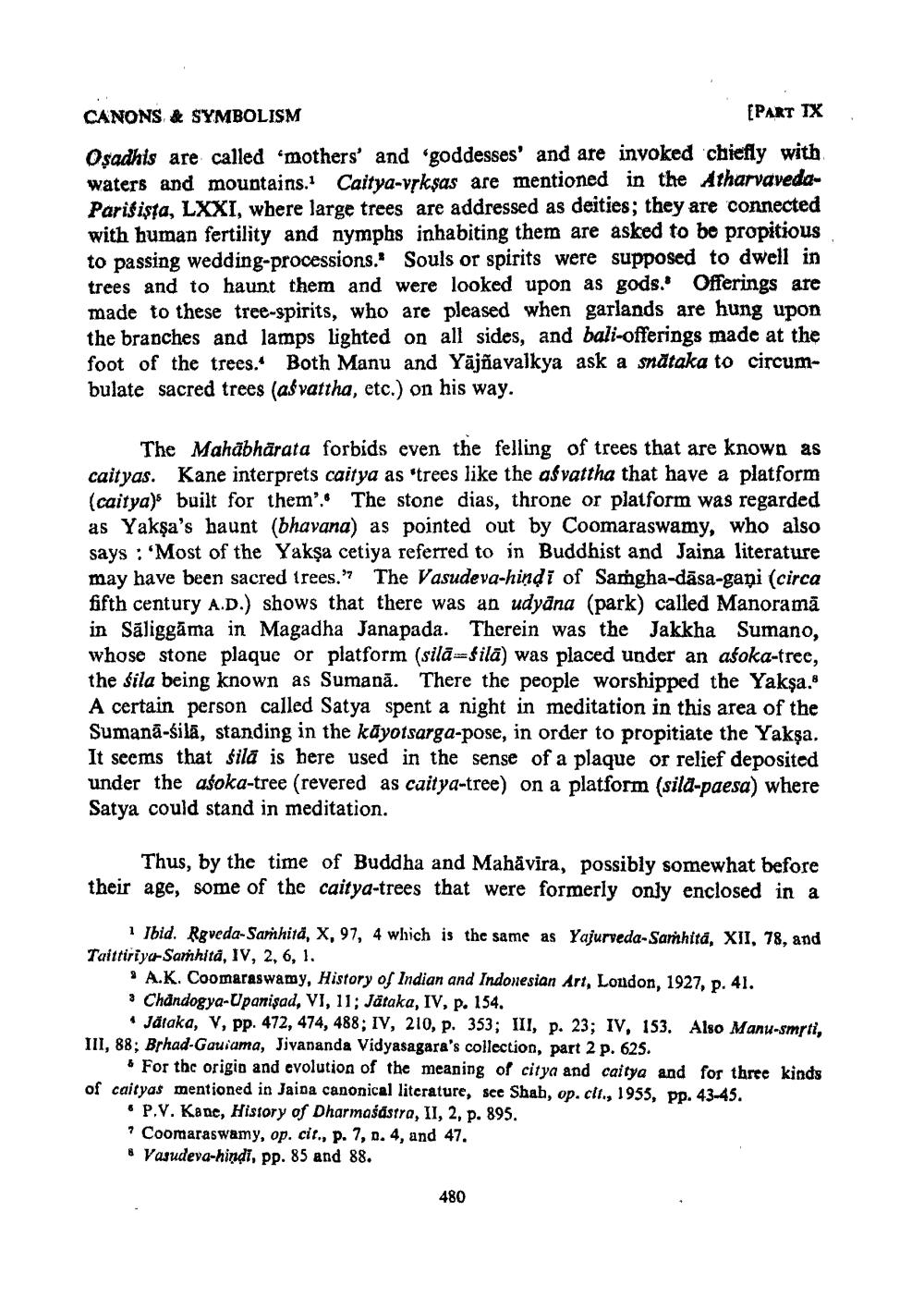________________
CANONS & SYMBOLISM
[PART IX Osadhis are called 'mothers' and goddesses' and are invoked chiefly with waters and mountains. Caitya-vsksas are mentioned in the AtharvavedaParisista, LXXI, where large trees are addressed as deities; they are connected with human fertility and nymphs inhabiting them are asked to be propitious to passing wedding-processions. Souls or spirits were supposed to dwell in trees and to haunt them and were looked upon as gods. Offerings are made to these tree-spirits, who are pleased when garlands are hung upon the branches and lamps lighted on all sides, and bali-offerings made at the foot of the trees. Both Manu and Yājñavalkya ask a snataka to circumbulate sacred trees (asvattha, etc.) on his way.
The Mahabharata forbids even the felling of trees that are known as cait yas. Kane interprets caitya as 'trees like the asvattha that have a platform (caitya)s built for them. The stone dias, throne or platform was regarded as Yakşa's haunt (bhavana) as pointed out by Coomaraswamy, who also says : 'Most of the Yakşa cetiya referred to in Buddhist and Jaina literature may have been sacred trees.'? The Vasudeva-hindi of Samgha-dāsa-gani (circa fifth century A.D.) shows that there was an udyana (park) called Manoramā in Săliggāma in Magadha Janapada. Therein was the Jakkha Sumano, whose stone plaque or platform (silā=filā) was placed under an aśoka-tree, the fila being known as Sumanā. There the people worshipped the Yakşa. A certain person called Satya spent a night in meditation in this area of the Sumanā-sila, standing in the kāyotsarga-pose, in order to propitiate the Yakşa. It seems that sila is here used in the sense of a plaque or relief deposited under the aśoka-tree (revered as caitya-tree) on a platform (sila-paesa) where Satya could stand in meditation.
Thus, by the time of Buddha and Mahavira, possibly somewhat before their age, some of the caitya-trees that were formerly only enclosed in a
1 Ibid. Rgveda-Samhita, X, 97, 4 which is the same as Yajurveda-Samhita, XII, 78, and Taittiriya-Saṁhita, IV, 2, 6, 1.
* A.K. Coomaraswamy, History of Indian and Indonesian Art, London, 1927, p. 41. : Chåndogya-Upanişad, VI, 11; Jätaka, IV, p. 154.
Jätaka, V, pp. 472, 474, 488; IV, 210, p. 353; III, p. 23; IV, 153. Also Manu-smrti, III, 88; Brhad-Gauiama, Jivananda Vidyasagara's collection, part 2 p. 625.
For the origin and evolution of the meaning of citya and caitya and for three kinds of caityas mentioned in Jaina canonical literature, see Shab, op. cit., 1955, pp. 43-45.
• P.V. Kane, History of Dharmasastra, II, 2, p. 895. ? Coomaraswamy, op. cit., p. 7, o. 4, and 47. & Vasudeva-hindi, pp. 85 and 88.
480




